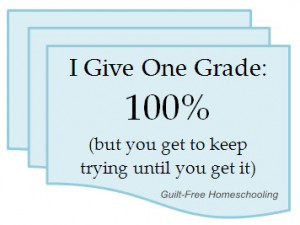For all of the readers who have requested it, a sample homeschool high school transcript is now available. This one is modeled after the examples in the book And What About College? by Cafi Cohen. We listed anything that received significant time and attention during the high school years as a class and referred to a course catalog from our local community college for help in writing our own course descriptions. The Carnegie credit standard refers to 120 or more contact hours, but the focused attention of homeschooling can condense that time into a shorter period. Essentially, if my student devoted considerable time and attention to a subject, I gave credit for that subject. A more complete description can be found in the article, Transcript Writing.
This six-page document is reduced in size on this website, so if you prefer to enlarge it, you will need to hold your mouse over each page/photo and use the third-mouse-button “Save Picture as…” command. Then you can open your saved photo and zoom in or print the photo to read it more clearly.
A sample homeschool high school diploma is also available, as is my son’s tongue-in-cheek graduation announcement. (Wording on a diploma you design should reflect your own state’s laws governing homeschooling.)
Click to view the desired document:
Transcript
Diploma
Graduation Announcement



 Guilt-Free Homeschooling is the creation of Carolyn Morrison and her daughter, Jennifer Leonhard. After serious disappointments with public school, Carolyn spent the next 11 years homeschooling her two children, from elementary to high school graduation and college admission. Refusing to force new homeschooling families to re-invent the wheel, Carolyn and Jennifer now share their encouragement, support, tips, and tricks, filling their blog with "all the answers we were looking for as a new-to-homeschooling family" and making this website a valuable resource for parents, not just a daily journal. Guilt-Free Homeschooling -- Equipping Parents for Homeschooling Success!
Guilt-Free Homeschooling is the creation of Carolyn Morrison and her daughter, Jennifer Leonhard. After serious disappointments with public school, Carolyn spent the next 11 years homeschooling her two children, from elementary to high school graduation and college admission. Refusing to force new homeschooling families to re-invent the wheel, Carolyn and Jennifer now share their encouragement, support, tips, and tricks, filling their blog with "all the answers we were looking for as a new-to-homeschooling family" and making this website a valuable resource for parents, not just a daily journal. Guilt-Free Homeschooling -- Equipping Parents for Homeschooling Success!

Recent Comments